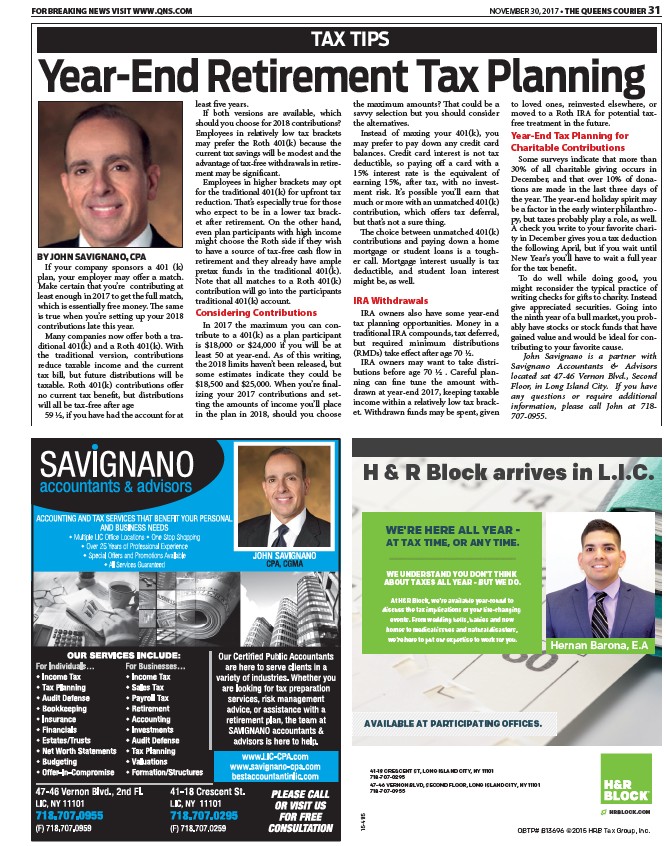
FOR BREAKING NEWS VISIT WWW.QNS.COM NOVEMBER 30, 2017 • THE QUEENS COURIER 31
Year-End Retirement Tax Planning
BY JOHN SAVIGNANO, CPA
If your company sponsors a 401 (k)
plan, your employer may offer a match.
Make certain that you’re contributing at
least enough in 2017 to get the full match,
which is essentially free money. The same
is true when you’re setting up your 2018
contributions late this year.
Many companies now offer both a traditional
401(k) and a Roth 401(k). With
the traditional version, contributions
reduce taxable income and the current
tax bill, but future distributions will be
taxable. Roth 401(k) contributions offer
no current tax benefit, but distributions
will all be tax-free after age
59 ½, if you have had the account for at
least five years.
If both versions are available, which
should you choose for 2018 contributions?
Employees in relatively low tax brackets
may prefer the Roth 401(k) because the
current tax savings will be modest and the
advantage of tax-free withdrawals in retirement
may be significant.
Employees in higher brackets may opt
for the traditional 401(k) for upfront tax
reduction. That’s especially true for those
who expect to be in a lower tax bracket
after retirement. On the other hand,
even plan participants with high income
might choose the Roth side if they wish
to have a source of tax-free cash flow in
retirement and they already have ample
pretax funds in the traditional 401(k).
Note that all matches to a Roth 401(k)
contribution will go into the participants
traditional 401(k) account.
Considering Contributions
In 2017 the maximum you can contribute
to a 401(k) as a plan participant
is $18,000 or $24,000 if you will be at
least 50 at year-end. As of this writing,
the 2018 limits haven’t been released, but
some estimates indicate they could be
$18,500 and $25,000. When you’re finalizing
your 2017 contributions and setting
the amounts of income you’ll place
in the plan in 2018, should you choose
the maximum amounts? That could be a
savvy selection but you should consider
the alternatives.
Instead of maxing your 401(k), you
may prefer to pay down any credit card
balances. Credit card interest is not tax
deductible, so paying off a card with a
15% interest rate is the equivalent of
earning 15%, after tax, with no investment
risk. It’s possible you’ll earn that
much or more with an unmatched 401(k)
contribution, which offers tax deferral,
but that’s not a sure thing.
The choice between unmatched 401(k)
contributions and paying down a home
mortgage or student loans is a tougher
call. Mortgage interest usually is tax
deductible, and student loan interest
might be, as well.
IRA Withdrawals
IRA owners also have some year-end
tax planning opportunities. Money in a
traditional IRA compounds, tax deferred,
but required minimum distributions
(RMDs) take effect after age 70 ½.
IRA owners may want to take distributions
before age 70 ½ . Careful planning
can fine tune the amount withdrawn
at year-end 2017, keeping taxable
income within a relatively low tax bracket.
Withdrawn funds may be spent, given
to loved ones, reinvested elsewhere, or
moved to a Roth IRA for potential taxfree
treatment in the future.
Year-End Tax Planning for
Charitable Contributions
Some surveys indicate that more than
30% of all charitable giving occurs in
December, and that over 10% of donations
are made in the last three days of
the year. The year-end holiday spirit may
be a factor in the early winter philanthropy,
but taxes probably play a role, as well.
A check you write to your favorite charity
in December gives you a tax deduction
the following April, but if you wait until
New Year’s you’ll have to wait a full year
for the tax benefit.
To do well while doing good, you
might reconsider the typical practice of
writing checks for gifts to charity. Instead
give appreciated securities. Going into
the ninth year of a bull market, you probably
have stocks or stock funds that have
gained value and would be ideal for contributing
to your favorite cause.
John Savignano is a partner with
Savignano Accountants & Advisors
located sat 47-46 Vernon Blvd., Second
Floor, in Long Island City. If you have
any questions or require additional
information, please call John at 718-
707-0955.
TAX TIPS
H & R Block arrives in L.I.C.
15-485
HRBLOCK.COM
WE'RE HERE ALL YEAR -
AT TAX TIME, OR ANY TIME.
WE UNDERSTAND YOU DON'T THINK
ABOUT TAXES ALL YEAR - BUT WE DO.
OBTP# B13696 ©2015 HRB Tax Group, Inc.
At H&R Block, we're available year-round to
discuss the tax implications of your life-changing
events. From wedding bells, babies and new
homes to medical issues and natural disasters,
we're here to put our expertise to work for you.
AVAILABLE AT PARTICIPATING OFFICES.
41-18 CRESCENT ST, LONG ISLAND CITY, NY 11101
718-707-0295
47-46 VERNON BLVD, SECOND FLOOR, LONG ISLAND CITY, NY 11101
718-707-0955
Hernan Barona, E.A